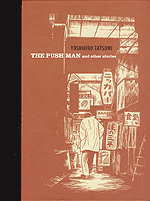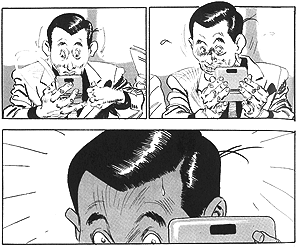
|
Tatsumi's The Push Man collects stories written in 1969, with an eye towards annual volumes that will collect more of this prolific artist's decades-long career. Totally absent of giant robots, schoolgirl romantic melodrama or any manner of supernatural beings, the stories of The Push Man are set exclusively in the gritty, working-class world of Japan's modern cities. Mostly kept to eight pages due to their original appearance in a Japanese comic anthology, they are endlessly inventive, compact tales full of cruel irony, quiet desperation and schadenfreude. Editor Adrian Tomine (author of Summer Blonde), correctly points out in the introduction that the naturalism of Tatsumi's 1969 stories are wildly ahead of their time in comparison with the U.S., when the underground comix scene had only just barely begun.
Tatsumi's characters include the sewer worker who encounters aborted fetuses, the pornographic film projectionist whose only turn-on is bathroom wall art and a metal puncher who sacrifices his hand for the insurance money. Some stories, like the titular one, are just enigmatic portraits of modern strife. In it, the Push Man, a student who earns extra money by cramming people into subway trains during rush hours, has the tables turned on him when he meets a sexually aggressive woman whose equally voracious girlfriends work him into a corner and tear his clothes off. The story ends on a day when the crowds overwhelm the Push Man and he becomes trapped on the moving train, helplessly pleading to be let off, "I'm the Push Man!"
 The push man gets a taste of his own medicine in Tatsumi's "The Push Man"
The push man gets a taste of his own medicine in Tatsumi's "The Push Man" |
By focusing on Japan's urban underclass, Tatsumi's stories feature many characters traditional to crime melodrama — pimps, prostitutes and hitmen — but without the glamour often associated with them. They toil and suffer in their labor as miserably as their counterparts in the "straight" world. The pimp, for example, begins to hate himself for sponging off of his prostitute girlfriend. So he runs off with another girl to the country to start a new life. On the way she says, "I'll work hard and take care of you," as he looks at her askance. Who among us hasn't made the same mistake twice? In Tatsumi's world, you can't win.
To Americans, Tatsumi's artwork will be as unexpected as his storytelling. It has nothing of the exaggerated manga style, instead embracing a naturalism that reflects the stories. The black and white brushwork has a loose quality to it, providing details of environment and character without being overly fussy. Tatsumi has a masterful talent for economizing, cramming as much depth of character, symbolism and drama into eight pages as many conventional manga only manage in 200 pages. That he often does this with practically no dialogue is a testament to his skills as a visual storyteller. Frequently the main character remains mute until the last frame where he might rhetorically ask, "How could this have happened?" Or he has an existentialist insight, like "To survive in the crowd, you have to struggle alone."
Unfortunately, though, as one goes through the book, a distinct malodor of misogyny begins to build. All the main characters are men, most of who have horrid relationships with shrewish wives or girlfriends. This theme reaches its nadir in the depressing story titled "Bedridden," about a woman we never see and who never speaks, hidden under the bed covers since she has somehow been "re-shaped to please men" as a sex slave. The twist of the story — that men kill each other to become her "master" — doesn't make up for such a nasty premise. To be fair, in an epilogue the author writes, "The true scope of my work can only be understood after you have read my later stories." Sexism aside, The Push Man collection feels as fresh and revelatory as when the works of Japanese cinema first began arriving in the U.S.

|
Seyeong O's Buja's Diary may be even more shocking to U.S. readers given the dearth of comix from South Korea. Called "manwha" in their native country, the few examples published in the U.S. by the likes of Tokyopop are indistinguishable from their Japanese counterparts in their adolescent focus. Buja's Diary, which, like The Push Man, is also a collection of short, naturalistic stories (originally published between 1988 and 1993) may be the first U.S.-published manhwa that feels truly Korean both in setting and unique cultural concerns. Though O shares with Tatsumi an interest in telling tales of more ordinary lives, he does so with much greater empathy for his characters and their plights. Without resorting to easy resolutions, O cultivates a subtle streak of morality to many of these tales.
Buja's Diary also has a greater variety of scenes than The Push Man, taking place alternately in the country or city, in modern times and in years past. The lovely opening story, "The Little Alley Watcher," sets the tone for the rest of the book. Drawn in a painterly palate of grey washes, it depicts a little girl alone on a countryside hill overlooking an empty hut. O builds the lonely and distressing atmosphere through quiet panels of hanging laundry, a dog pulling desperately on its chain and an ant hauling a dead butterfly across the ground. Eventually our anxiety for the child breaks as her parents arrive — they had been spraying insecticide in the fields — and embrace her. But their talk reveals the disturbing reason for her total abandonment. The village has emptied in favor of the lure of the big city. So, for O, a little girl can signify the cost of a vast cultural shift.
 A bad hair day in Seyeong O's "Buja's Diary"
A bad hair day in Seyeong O's "Buja's Diary" |
Other stories take on similarly major themes in the form of small family dramas. In "Tear Gas" a man rides on a train to the arranged marriage of his daughter. As he rides, the story flashes back to the Korean War when, as a child, he helplessly watches his father being dragged off by communist soldiers through the haze of a village smudge pot. Now a firm member of the middle class, and so staunchly nationalist that he insists on his daughter marrying a policeman in spite of her obvious unhappiness, he arrives in the city just as an anti-government student protest breaks out. Shouting invectives at the students, he sees his son dragged off through the tear gas by the authorities. O wisely provides no obvious resolution to this estrangement of generations, simply ending with, "The time for his daughter's Engagement came and went as he continued to retch helplessly."
It's a shame that the poor production values of the book underserve O's fine artwork. He draws in a delicate style of highly realistic pen work, filled with careful detail taking particular delight in the variety of people's comical facial characteristics such as broken noses, buck teeth and wide foreheads. Although the printing is clear and the lines are sharp, there are no margins around the artwork, so the panels often bleed into the gutter of the spine. Sometimes you have to press the book with the palm of your hand to read the words. Dialogue has also been carelessly allowed to overlap the edges of the balloons in some cases and sound effects have been messily overlaid on the original Korean characters. It's frustrating when The Push Man, which costs the same as Buja's Diary, albeit at 80 fewer pages, comes in a hardcover, with better paper and vastly more care about the artwork. NBM needs to do Seyeong O better than this.
In spite of its printing drawbacks anyone with an interest in Asian or Korean culture — and anyone with an interest in fresh, humane comics storytelling — should seek out Seyeong O's Buja's Diary. Along with Yoshihiro Tatsumi's The Push Man, the two books reveal a side of Asian comix that could redefine the manga/manwha "genre" for most Americans by telling small, mature stories that are rich in complexity, humor and meaning in their unique way as any Western graphic literature.
